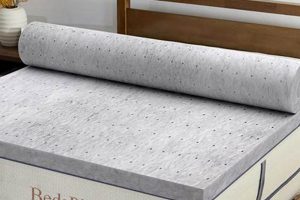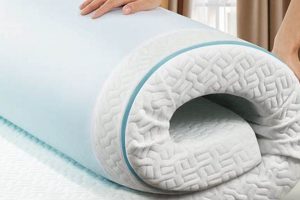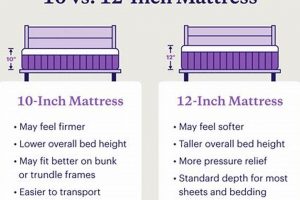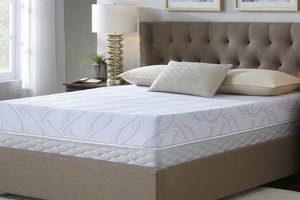A substantial sleep surface enhancement, a four-inch thick layer of viscoelastic foam provides a notable addition to an existing mattress. This bedding accessory is designed to contour to the body’s shape, distributing weight evenly and minimizing pressure points. As an example, placing this item atop a firm innerspring mattress can dramatically soften the sleep experience.
The significance of such a product lies in its capacity to improve sleep quality and alleviate discomfort. Historically, materials used for bedding offered limited support, leading to restless nights. The advent of pressure-relieving materials represented a significant advancement. The benefits extend beyond mere comfort; improved spinal alignment and reduced tossing and turning are frequently reported outcomes, potentially leading to enhanced rest and decreased morning stiffness.
The following sections will delve into specific aspects such as material composition, density considerations, the potential impact on temperature regulation during sleep, and factors to consider when selecting the appropriate model to meet individual needs and preferences, along with proper cleaning and maintenance to extend its lifespan.
Tips for Optimal Use and Care
Maximizing the benefits and longevity of a four-inch viscoelastic foam sleep surface requires careful consideration and adherence to specific guidelines.
Tip 1: Select Appropriate Density: Higher density foams generally offer greater support and durability, but may retain more heat. Lower density options provide enhanced conforming but might exhibit reduced lifespan.
Tip 2: Address Off-Gassing: Newly manufactured viscoelastic foam can emit volatile organic compounds (VOCs), resulting in a noticeable odor. Airing the product in a well-ventilated area for several days prior to use can mitigate this issue.
Tip 3: Utilize a Mattress Protector: A waterproof and breathable mattress protector shields the foam from spills, stains, and dust mites, extending its lifespan and maintaining hygiene.
Tip 4: Rotate Regularly: Rotating the sleep surface 180 degrees every few months promotes even wear and prevents indentations from forming in frequently used areas.
Tip 5: Avoid Direct Sunlight: Prolonged exposure to direct sunlight can degrade the foam’s structure and cause discoloration. Shield the product from direct sunlight when not in use.
Tip 6: Clean with Care: Spot clean spills immediately with a mild detergent and a damp cloth. Avoid soaking the foam, as it can be difficult to dry completely and may foster mold growth.
Tip 7: Consider Underlayment: The quality of the mattress beneath the accessory significantly impacts its performance. Ensure the underlying mattress provides adequate support to prevent premature sagging.
By following these recommendations, individuals can optimize the comfort, support, and lifespan of their four-inch viscoelastic foam bedding addition, thereby enhancing their sleep experience.
The concluding section will summarize the key advantages and considerations discussed, providing a comprehensive overview of these products and their potential to improve sleep quality.
1. Pressure Relief
Pressure relief is a primary consideration when evaluating bedding surfaces, playing a critical role in minimizing discomfort and promoting restful sleep. In the context of a four-inch viscoelastic foam bedding addition, pressure relief refers to the material’s ability to redistribute weight and reduce concentrated forces on specific areas of the body.
- Weight Distribution Mechanics
The viscoelastic nature of memory foam allows it to conform to the body’s contours, thereby increasing the surface area in contact with the sleep surface. This broader contact area reduces the force per unit area, mitigating pressure points that can cause pain and discomfort. For instance, areas such as the hips and shoulders, which typically bear the brunt of weight during sleep, experience reduced pressure when in contact with viscoelastic foam.
- Impact on Spinal Alignment
Proper spinal alignment is crucial for minimizing muscle strain and promoting healthy posture during sleep. By conforming to the body’s natural curves, a four-inch viscoelastic foam layer can support the spine in a neutral position, reducing pressure on the intervertebral discs and surrounding tissues. This support is especially beneficial for individuals with pre-existing back pain or spinal conditions.
- Circulatory Benefits
Prolonged pressure on certain areas of the body can restrict blood flow, leading to discomfort and the need to shift positions frequently during sleep. By reducing pressure points, a viscoelastic foam layer promotes healthy circulation, allowing blood to flow freely and reducing the likelihood of numbness, tingling, or pain that can disrupt sleep.
- Material Density and Firmness Influence
The density and firmness of the viscoelastic foam directly impact its pressure-relieving capabilities. Higher density foams generally provide more support and resist compression, while lower density foams offer greater conforming ability and pressure redistribution. The optimal choice depends on individual preferences and body weight; heavier individuals may require higher density foams for adequate support, while lighter individuals may prefer lower density options for enhanced pressure relief.
In summary, the pressure-relieving characteristics of a four-inch viscoelastic foam bedding addition stem from its ability to conform to the body, distribute weight evenly, and promote spinal alignment. These factors contribute to reduced discomfort, improved circulation, and ultimately, enhanced sleep quality. The effectiveness of pressure relief is significantly influenced by both the material’s density and firmness, requiring careful consideration during the selection process.
2. Conforming Support
Conforming support represents a crucial characteristic of sleep surface enhancements, particularly pertinent when examining the utility of a four-inch viscoelastic foam addition. This attribute describes the ability of the material to adapt to the unique contours of an individual’s body, providing tailored support that minimizes pressure points and promotes proper spinal alignment.
- Body Contour Accommodation
Viscoelastic foam’s open-cell structure enables it to respond to both weight and temperature, gradually molding to the sleeper’s form. This accommodation distributes weight across a larger surface area, reducing localized pressure on prominent joints such as the hips and shoulders. For instance, a side sleeper’s shoulder, which typically experiences concentrated pressure, benefits from the foam’s ability to compress and cradle the joint, promoting greater comfort and reducing the likelihood of pain or numbness.
- Spinal Alignment Maintenance
Maintaining correct spinal alignment during sleep is essential for preventing back pain and promoting musculoskeletal health. A four-inch viscoelastic foam layer, through its conforming capabilities, fills the gaps between the mattress and the body, providing support to the lumbar region for back sleepers and ensuring the spine remains relatively straight for side sleepers. This consistent support mitigates spinal curvature and reduces strain on surrounding muscles and ligaments.
- Motion Isolation Properties
The conforming nature of viscoelastic foam also contributes to motion isolation, which is particularly beneficial for couples sharing a bed. When one sleeper moves, the foam absorbs the motion rather than transmitting it across the entire surface. This minimizes disturbances and allows the other sleeper to remain undisturbed, promoting more restful sleep. The degree of motion isolation is directly related to the density and thickness of the viscoelastic foam; a four-inch layer provides a substantial level of isolation compared to thinner options.
- Density and Firmness Influence
The density and firmness of the viscoelastic foam significantly impact its conforming support characteristics. Higher density foams offer greater support and resistance to compression, making them suitable for heavier individuals or those who prefer a firmer sleep surface. Lower density foams conform more readily to the body’s contours but may provide less support for heavier individuals. The optimal choice depends on individual preferences, body weight, and sleeping position. Balancing density and firmness is essential for achieving optimal conforming support and maximizing the benefits of a four-inch viscoelastic foam bedding addition.
In conclusion, the attribute of conforming support, as exhibited by a four-inch viscoelastic foam bedding addition, plays a vital role in promoting comfort, spinal alignment, motion isolation, and overall sleep quality. Careful consideration of material density and firmness is paramount to ensure that the product aligns with individual needs and preferences, maximizing the potential benefits of this sleep surface enhancement.
3. Density Variations
Density variations in a four-inch viscoelastic foam layer exert a profound influence on its performance characteristics, including support, durability, and temperature regulation. Density, measured in pounds per cubic foot (PCF), directly correlates with the material’s capacity to resist compression and its overall lifespan. A higher density foam generally offers greater support, preventing the sleeper from sinking excessively into the material and maintaining spinal alignment. Conversely, lower density foams conform more readily to body contours, potentially enhancing pressure relief but at the expense of long-term durability and support. For example, a 5 PCF foam will provide more robust support than a 3 PCF foam, making it suitable for heavier individuals or those seeking firmer support. Conversely, a 3 PCF foam might be preferable for lighter individuals prioritizing enhanced contouring and pressure relief.
The impact of density on temperature regulation is also significant. Higher density foams tend to retain more heat due to their reduced airflow, potentially leading to discomfort for sleepers prone to overheating. Lower density foams, with their more open-cell structure, allow for greater airflow and heat dissipation, offering a cooler sleep experience. Manufacturers often incorporate design features such as gel infusions or convoluted surfaces to mitigate heat retention in higher density foams. The choice of density, therefore, requires careful consideration of individual sleeping habits, body weight, and sensitivity to temperature.
In summary, density is a critical determinant of a four-inch viscoelastic foam layer’s overall effectiveness. While higher densities offer superior support and durability, lower densities provide enhanced conforming and potentially better temperature regulation. Selecting the appropriate density involves balancing these trade-offs to align with individual needs and preferences, ultimately influencing the quality and comfort of the sleep experience.
4. Temperature Regulation
Viscoelastic foam, particularly in a four-inch layer, inherently presents challenges to temperature regulation during sleep. The material’s dense structure, which contributes to its pressure-relieving properties, also impedes airflow and can trap body heat. This characteristic often leads to increased surface temperature, potentially causing discomfort and disrupting sleep patterns. Individuals prone to night sweats or those living in warmer climates may find that a standard four-inch viscoelastic foam surface exacerbates these issues. For example, studies have shown that traditional viscoelastic foam can elevate skin temperature by several degrees Celsius compared to conventional innerspring mattresses, resulting in more frequent tossing and turning as the body attempts to dissipate heat.
To mitigate the heat retention associated with viscoelastic foam, manufacturers have developed several strategies aimed at improving airflow and promoting heat dissipation. These include incorporating open-cell foam structures, which allow for greater air circulation, and infusing the foam with cooling agents such as gel particles or phase-change materials. Open-cell foam, while improving breathability, may also slightly reduce the density and supportiveness of the material. Gel-infused viscoelastic foam absorbs body heat and releases it gradually, providing a temporary cooling effect. Phase-change materials go a step further by absorbing heat and undergoing a phase transition, storing the heat until the surrounding temperature drops, at which point it is released. The effectiveness of these cooling technologies varies, and the optimal choice depends on individual sensitivity to temperature and environmental conditions. It’s important to consider the long-term performance of these cooling features, as some may degrade over time, reducing their effectiveness.
The implications of temperature regulation extend beyond mere comfort; maintaining a stable sleep temperature is crucial for optimal physiological function. Elevated body temperature during sleep can disrupt hormone regulation and interfere with the body’s natural sleep-wake cycle. Selecting a four-inch viscoelastic foam surface that effectively addresses temperature regulation is therefore essential for promoting restful and restorative sleep. Consumers should carefully evaluate the cooling technologies employed in the foam and consider their individual needs and preferences when making a purchase. While viscoelastic foam offers undeniable benefits in terms of pressure relief and support, its potential impact on temperature regulation must be carefully considered to ensure a comfortable and healthy sleep environment.
5. Durability Factors
The lifespan of a four-inch viscoelastic foam mattress addition is significantly influenced by several key factors. Understanding these determinants is essential for making informed purchasing decisions and ensuring long-term satisfaction with the product.
- Foam Density
Density, measured in pounds per cubic foot (PCF), is a primary indicator of durability. Higher density foams generally exhibit greater resistance to compression and deformation over time. A foam with a density of 4 PCF or higher is typically considered more durable than a lower density counterpart (e.g., 3 PCF). Lower density foams are prone to sagging and developing impressions, particularly in areas where weight is concentrated, leading to a reduced lifespan. For instance, a higher density foam mattress addition will likely retain its shape and support for a longer period compared to a lower density one under similar usage conditions.
- Material Composition
The type of viscoelastic foam used affects its durability. Traditional viscoelastic foam, while offering pressure relief, can be susceptible to degradation from moisture and body oils. Newer formulations, incorporating plant-based oils or advanced polymer blends, may exhibit enhanced resistance to breakdown. Additionally, the presence of additives, such as antioxidants or antimicrobial agents, can contribute to the foam’s longevity by preventing oxidation and inhibiting microbial growth. The source and quality control measures implemented during the manufacturing process also play a significant role in determining the consistency and durability of the final product.
- Manufacturing Process
The methods used to manufacture the viscoelastic foam influence its structural integrity and, consequently, its durability. Processes such as open-cell foam production, which enhances airflow, can also slightly reduce the material’s density and, potentially, its lifespan. Conversely, techniques that promote uniform cell structure and minimize air pockets contribute to greater durability. Furthermore, the curing process, which involves heat treatment to solidify the foam, must be carefully controlled to prevent premature degradation or structural weaknesses. Adherence to industry standards and rigorous quality testing throughout the manufacturing process are crucial for ensuring a durable final product.
- Usage and Maintenance
The way a four-inch viscoelastic foam addition is used and maintained significantly impacts its lifespan. Regular rotation of the product, typically every few months, promotes even wear and prevents the formation of impressions. The use of a mattress protector safeguards the foam from spills, stains, and dust mites, all of which can contribute to premature degradation. Proper ventilation is essential to prevent moisture buildup, which can foster mold growth and accelerate the breakdown of the foam. Avoiding excessive weight or concentrated pressure on specific areas of the product will also prolong its lifespan. Adhering to the manufacturer’s care instructions and implementing proactive maintenance practices are crucial for maximizing the durability of a four-inch viscoelastic foam mattress addition.
The interplay of foam density, material composition, manufacturing process, and usage patterns collectively determines the durability of a four-inch viscoelastic foam mattress addition. Understanding these factors empowers consumers to select a product that meets their individual needs and offers long-term value, ensuring a comfortable and supportive sleep surface for years to come. Careful consideration of these aspects, coupled with proper care and maintenance, will maximize the lifespan and performance of the chosen foam.
6. Thickness Impact
The thickness of a viscoelastic foam layer, specifically a four-inch variant, directly influences its performance characteristics and suitability for diverse sleep preferences. The increase in thickness, compared to thinner alternatives, yields a noticeable enhancement in pressure relief and conforming support. The greater material volume allows for more pronounced contouring to the body’s unique shape, distributing weight more evenly and minimizing concentrated pressure points. As a result, individuals experiencing joint pain or discomfort may find significant relief with a four-inch layer, as it reduces stress on sensitive areas such as the hips and shoulders. A thinner layer, conversely, may not provide sufficient cushioning, leading to persistent discomfort.
The practical significance of this increased thickness extends to spinal alignment. A four-inch layer provides greater capacity to fill the gaps between the body and the underlying mattress, maintaining a neutral spinal position, particularly for side sleepers. Inadequate thickness can lead to spinal misalignment, potentially exacerbating back pain and stiffness. Furthermore, the four-inch profile offers improved motion isolation, minimizing the transfer of movement across the sleep surface. This benefit is particularly relevant for couples, where one partner’s movements can disrupt the other’s sleep. Real-life examples demonstrate that couples transitioning from thinner mattress additions to a four-inch viscoelastic foam layer often report a decrease in sleep disturbances and improved overall sleep quality.
In summary, the thickness of a four-inch viscoelastic foam mattress addition serves as a critical determinant of its performance. The increase in thickness delivers enhanced pressure relief, superior spinal alignment, and improved motion isolation compared to thinner options. Understanding the implications of thickness allows consumers to make informed decisions, selecting a product that aligns with their individual needs and preferences, thereby optimizing sleep quality and comfort. However, the additional thickness may also contribute to increased heat retention; therefore, individuals should carefully consider this potential drawback in conjunction with the advantages offered by a four-inch profile.
Frequently Asked Questions
This section addresses common inquiries regarding the features, benefits, and practical considerations associated with a four-inch viscoelastic foam bedding addition.
Question 1: Does a four-inch viscoelastic foam layer adequately support individuals of higher weight?
The capacity of a four-inch viscoelastic foam layer to provide adequate support for heavier individuals hinges significantly on the density of the foam. Higher density foams, typically 4 PCF (pounds per cubic foot) or greater, offer enhanced resistance to compression and are generally recommended for individuals exceeding 200 pounds. Lower density foams may compress excessively, compromising spinal alignment and potentially reducing long-term durability.
Question 2: How does the thickness of a viscoelastic foam pad impact temperature regulation during sleep?
Increased thickness can potentially exacerbate heat retention. Viscoelastic foam, by its nature, limits airflow. A four-inch layer may trap more body heat compared to thinner options. Mitigating strategies include selecting open-cell foam constructions, gel infusions, or incorporating phase-change materials designed to promote heat dissipation.
Question 3: What is the recommended cleaning protocol for a four-inch viscoelastic foam bedding addition?
Spot cleaning is the preferred method. Mild detergent solutions applied with a damp cloth can address minor stains. Soaking the foam is to be avoided, as complete drying is difficult, potentially fostering mold growth. Thorough air drying in a well-ventilated area is crucial following any cleaning procedure. The use of a waterproof mattress protector is strongly recommended to prevent staining and simplify cleaning.
Question 4: How frequently should a four-inch viscoelastic foam sleep surface be rotated?
Rotation every three to six months is advisable to promote even wear and prevent the formation of permanent impressions. Rotating the pad 180 degrees redistributes pressure and mitigates the concentration of weight on specific areas, thereby prolonging its lifespan.
Question 5: Does a new four-inch viscoelastic foam sleep surface emit an odor, and if so, what is the recommended course of action?
Newly manufactured viscoelastic foam can release volatile organic compounds (VOCs), resulting in a characteristic odor known as “off-gassing.” Airing the product in a well-ventilated area for several days prior to use typically dissipates the odor. While generally considered harmless, individuals with heightened sensitivities may wish to expedite this process.
Question 6: What is the typical lifespan of a four-inch viscoelastic foam bedding enhancement?
Lifespan varies based on foam density, usage patterns, and maintenance practices. Higher density foams, with proper care, can last five to seven years or longer. Lower density foams may exhibit signs of compression and diminished support within a shorter timeframe. Regular rotation, the use of a mattress protector, and avoidance of excessive weight contribute to maximizing the product’s longevity.
In summary, diligent adherence to recommended care protocols and mindful consideration of individual needs and preferences are crucial for maximizing the benefits and lifespan of a four-inch viscoelastic foam bedding addition.
The subsequent section will provide practical considerations for selecting the appropriate model to meet individual requirements.
Conclusion
The preceding exploration of the “4 inch memory foam mattress pad” has illuminated its multifaceted nature, highlighting key attributes such as pressure relief, conforming support, density variations, temperature regulation, durability factors, and the impact of its thickness. The information presented underscores the importance of careful consideration of individual needs and preferences when selecting such a product. The characteristics discussed directly influence the overall sleep experience, determining the degree of comfort, support, and long-term satisfaction.
The decision to incorporate a “4 inch memory foam mattress pad” represents a significant investment in sleep quality. Individuals are encouraged to assess their specific requirements and weigh the trade-offs associated with different foam densities, cooling technologies, and maintenance practices. A well-informed choice, coupled with diligent care, will maximize the potential benefits and ensure the longevity of this sleep surface enhancement, ultimately contributing to improved rest and overall well-being.


![Best 4 Inch Memory Foam Mattress [Guide + Deals!] Organic & Natural Mattress Buyer’s Guide: Non-Toxic Sleep Solutions Best 4 Inch Memory Foam Mattress [Guide + Deals!] | Organic & Natural Mattress Buyer’s Guide: Non-Toxic Sleep Solutions](https://mattressworldpa.com/wp-content/uploads/2025/07/th-3697-300x200.jpg)



![Best 12 Inch Queen Memory Foam Mattress [Guide] Organic & Natural Mattress Buyer’s Guide: Non-Toxic Sleep Solutions Best 12 Inch Queen Memory Foam Mattress [Guide] | Organic & Natural Mattress Buyer’s Guide: Non-Toxic Sleep Solutions](https://mattressworldpa.com/wp-content/uploads/2025/07/th-3693-300x200.jpg)
